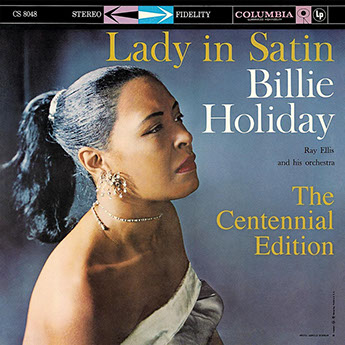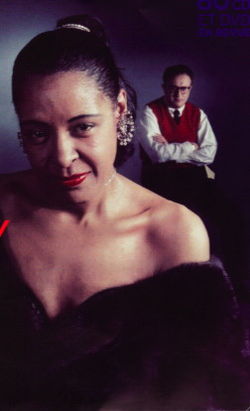
 The Story of 'Lady In Satin'
The Story of 'Lady In Satin'
Lady in Satin is an album by jazz singer Billie Holiday released in 1958 on Columbia Records. It is the penultimate album completed by the singer and last released in her lifetime (her final album, Billie Holiday, being recorded in March 1959 and released just after her death). The original album was produced by Irving Townsend, and engineered by Fred Plaut.
For the majority of the 1950s, Billie Holiday was signed to jazz producer Norman Granz's Clef Records, which was later absorbed into the newly founded Verve Records by 1956. All of her work for Norman Granz consisted of small jazz combos, reuniting her with musicians she recorded with back in the 1930s when she made her first recordings with Teddy Wilson. There were talks in the early 1950s of Holiday making albums, or songbooks, dedicated to composers such as George and Ira Gershwin and Jerome Kern, but they fell through and ended up going to Ella Fitzgerald when she signed to Verve. By 1957, Holiday had recorded twelve albums for Granz and was unhappy. Therefore she decided not to renew her contract.
By October 1957, Holiday contacted Columbia producer Irving Townsend and expressed interest in recording with bandleader Ray Ellis after listening to his album 'Ellis in Wonderland'. Originally, she wanted to do an album with bandleader Nelson Riddle after hearing his arrangements for Frank Sinatra's albums, particularly 'In the Wee Small Hours', but after hearing Ellis' version of 'For All We Know', she wanted to record with him. When Holiday came to Townsend about the album, he was surprised: "It would be like Ella Fitzgerald saying that she wanted to record with Ray Conniff. But she said she wanted a pretty album, something delicate. She said this over and over. She thought it would be beautiful. She wasn't interested in some wild swinging jam session...She wanted that cushion under her voice. She wanted to be flattered by that kind of sound."
 Townsend got in touch with Ellis about the album. Ellis, having heard of Holiday's work throughout the 1930s and 1940s, was excited for the project, saying "I couldn't believe it...I didn't know she was aware of me." Townsend arranged a meeting for both Holiday and Ellis to sign a contract with Columbia. Columbia provided an unlimited budget for the album. The musicians in the orchestra were paid $60 for the three sessions and Holiday was paid $150 per side in advance. Townsend went on to set up the recording dates for late February 1958.
Townsend got in touch with Ellis about the album. Ellis, having heard of Holiday's work throughout the 1930s and 1940s, was excited for the project, saying "I couldn't believe it...I didn't know she was aware of me." Townsend arranged a meeting for both Holiday and Ellis to sign a contract with Columbia. Columbia provided an unlimited budget for the album. The musicians in the orchestra were paid $60 for the three sessions and Holiday was paid $150 per side in advance. Townsend went on to set up the recording dates for late February 1958.
When Holiday signed her contract for Columbia, the label looked at it as new beginning, for this was her return back to the label after sixteen years. During Holiday's time with Norman Granz's label, she revisited old material she had previously recorded and songs that were well known in her repertoire, such as "My Man", "Lover, Come Back to Me", "I Cover the Waterfront", "Them There Eyes", "I Only Have Eyes for You" and others. Columbia wanted Holiday to do an album of songs she had never recorded before, so the song material for Lady in Satin derived from the usual sources for Holiday in her three decade career, that of the Great American Songbook of classic pop. Also, unlike the bulk of Holiday's recordings with Norman Granz and her early years at Columbia in the 1930s and early 1940s, rather than in the setting of a jazz combo Holiday returns to the backdrop of full orchestral arrangements as done during her Decca years eight years earlier. She wanted the album to be in the same contemporary vein of Frank Sinatra or Ella Fitzgerald on her Songbooks series.
Ray Ellis made his arrangements of the songs to match Holiday's voice. By the mid to late 1950s, Holiday's voice changed drastically due to years of alcohol and drug abuse, altering its texture and gave it a fragile, raspy sound. Despite her voice's setback, she never lost the edge that had always made it so distinctive and was able to still use her style of phrasing that made her a popular jazz singer. Ray Ellis said of Holiday's voice: "I heard her voice and I dug it. I was in love with that voice and I was picturing a very evil, sensuous, sultry, very evil...probably one of the most evil voices I've heard in my life...Evil is earthy to me. When you say someone is evil, it means very, very bad. I don't mean bad."
Ellis used a combination of 40 musicians in the orchestra, complete with horns, strings, reeds and even a three piece choir. It would turn out to be Holiday's most expensive music production. Soloists on the album included Mel Davis, Urbie Green, and bebop trombone pioneer J.J. Johnson.
Reaction to the album was mixed. Holiday's voice had lost much of its upper range in her 40s, although she still retained her rhythmic phrasing. The Penguin Guide to Jazz gave the album a three-star rating of a possible four stars, but expressed a basic reservation about the album, describing it as "a voyeuristic look at a beaten woman." The Rolling Stone Jazz Record Guide said "Lady in Satin presents the Lady overdressed. It's an album from the late Fifties, when much of Billie's punch was gone." However, trumpeter Buck Clayton preferred the work of the later Holiday to that of the younger woman that he had often worked with in the 1930s.
Ray Ellis said of the album in 1997: "I would say that the most emotional moment was her listening to the playback of 'I'm a Fool to Want You'. There were tears in her eyes... After we finished the album I went into the control room and listened to all the takes. I must admit I was unhappy with her performance, but I was just listening musically instead of emotionally. It wasn't until I heard the final mix a few weeks later that I realized how great her performance really was."
Lady in Satin was reissued by Legacy Records on September 23, 1997, remastering using 20-bit technology with four bonus tracks and was inducted into the Grammy Hall of Fame in 2000. In 2015, to mark the 100th anniversary of Billie's birth, a Centenary version of Lady In Satin was released. Not only the album but also two CD's worth of out-takes were included - the bits of the recording that were rejected. These out-takes reveal the atmosphere of the actual studio recording in Columbia's famous 30th Street Studio in New York and Billie's demeanour at the time.
Lady In Satin was never performed live. Not long after the recording, Billie went for an extended stay in Europe, returning to her deathbed in July 1959.
Photo credit: Arnold Newman

















